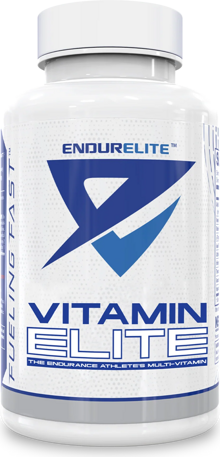
EndurElite Vitamin Elite
Go to Store
EndurElite Vitamin Elite
Go to StoreThe Endurance Athlete's Multivitamin
Packed with clinically dosed vitamins, minerals, and antioxidants, this multivitamin powerhouse is formulated to support your health, performance, and overall well-being. Our transparent label means you know exactly what you're taking, and how much of each ingredient. We've taken all the guess work out of endurance-focused vitamins by creating an all-in-one capsule that will help you perform at your very best, all the time.
- Complete Multivitamin With Fruits & Greens Superfood Blend
- Fills The Most Common Micronutrient Gaps In Endurance Athletes*
- Supports Peak Athletic Performance*
- Full Spectrum Vitamin B Profile
- Choline & Magnesium For Muscle & Cognitive Health*
- Patented Antioxidant Ingredient Spectra
- Piperine For Increased Absorption*
- 30 Servings Per Bottle
In a perfect world, endurance athletes would consume a well-balanced diet containing whole grains, fruits, and vegetables, thereby aiding in the assurance of the proper intake of all micronutrients. Unfortunately, in the real world, athletes do not have perfect diets. In today's society, the lack of time and the convenience of less-than-ideal food sources tempt people to ingest a diet lacking many of the essential vitamins and minerals needed to maintain a healthy lifestyle and fuel performance.
Vitamin Elite is an advanced, therapeutically dosed vitamin, mineral, and antioxidant formula designed specifically to meet the nutritional demands of endurance athletes in training and to fill micronutrient gaps left by an inadequate diet. Vitamin Elite goes beyond the minimum Recommended Daily Intake (RDI) to support optimal nutritional balance and peak physical and mental performance for elite athletes, weekend warriors, and fitness enthusiasts alike. Vitamins and minerals play critical roles in hundreds of bodily functions. Vitamin Elite acts as a foundation for those nutritional needs and ensures that all of the vital micronutrients and co-factors are available at the crucial times your body needs to perform optimally. We've created a multivitamin that focuses on athletes' needs.
Unlike most multivitamins that are built on fairy-dusted combinations of random micronutrients hidden in proprietary blends, Vitamin Elite combines clinically dosed, best-in-class ingredients precisely formulated to deliver exactly what you need to support health, performance, and overall well-being. With EndurElite, transparency and innovation are the name of the game and we do it better than anyone else in the endurance world. This transparency and innovation is reflected in the most superior multivitamin on the market today, Vitamin Elite. It has everything you need in one comprehensive, transparent label, clinically dosed formula, and nothing that you don't.




